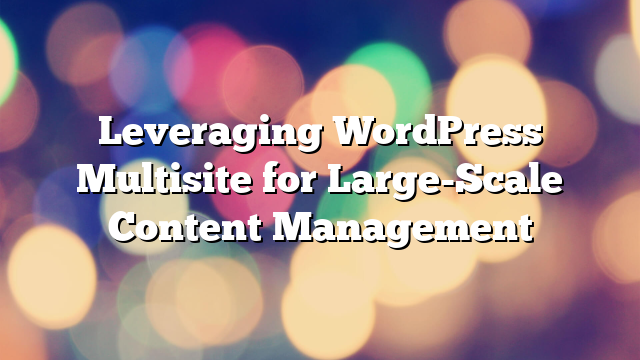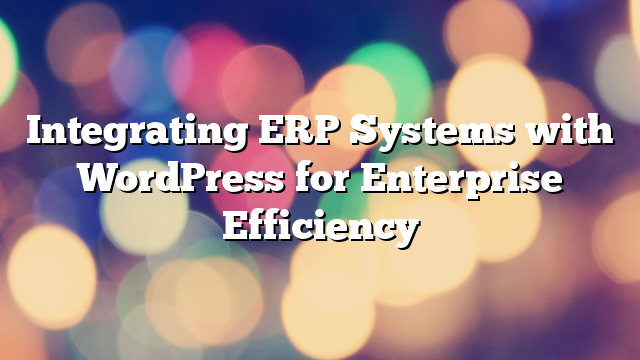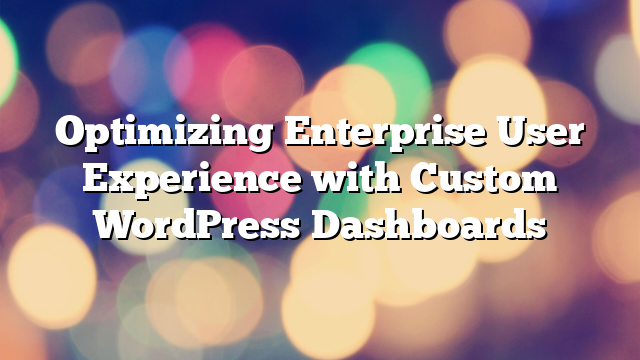Leveraging WordPress Multisite for Large-Scale Content Management
29.10.2024

As enterprises expand their online presence, the need for effective content management becomes increasingly critical. Managing multiple websites can pose significant challenges, from maintaining consistent branding to ensuring seamless updates across platforms. This is where WordPress Multisite comes into play. By enabling organizations to create and manage multiple sites from a single WordPress installation, Multisite offers a scalable and efficient solution for large-scale content management. In this article, we will explore the benefits of using WordPress Multisite for enterprises and how it can streamline your content management processes.
What Is WordPress Multisite?
WordPress Multisite is a feature that allows users to create a network of websites using a single WordPress installation. Instead of managing each website separately, administrators can control all sites from one dashboard. This feature is particularly beneficial for enterprises that operate multiple brands, products, or regional sites, as it simplifies management and reduces redundancy.
With WordPress Multisite, you can create new sites quickly, share themes and plugins across the network, and manage user roles and permissions efficiently. Each site in the network can have its unique settings, content, and functionality, allowing for both customization and consistency.
Benefits of Using WordPress Multisite for Enterprises
1. Centralized Management
One of the most significant advantages of WordPress Multisite is centralized management. With a single dashboard, administrators can manage all sites in the network without needing to log in to each one individually. This streamlined approach simplifies updates, theme management, and plugin installations, saving time and reducing the risk of errors.
For enterprises, this centralized control means that updates can be implemented across multiple sites simultaneously, ensuring consistency in performance and security. It also allows for easy monitoring of site activity, analytics, and user engagement from one place.
2. Cost Efficiency
Managing multiple standalone WordPress installations can lead to increased hosting costs, plugin purchases, and maintenance efforts. With WordPress Multisite, enterprises can save on hosting fees by using a single server to host all sites. Additionally, you only need to purchase plugins and themes once for the entire network, reducing overall costs.
Furthermore, the maintenance of a single WordPress installation is far less resource-intensive compared to managing multiple sites, allowing your IT team to focus on more strategic initiatives.
3. Consistent Branding and User Experience
For enterprises with multiple brands or regional websites, maintaining consistent branding is crucial. WordPress Multisite enables organizations to create uniformity in design and user experience across all sites while allowing for specific customizations where necessary.
By sharing themes and templates, enterprises can ensure that all websites adhere to brand guidelines, providing a seamless experience for users regardless of the site they visit. This consistency helps reinforce brand identity and build trust with customers.
4. Streamlined User Management
WordPress Multisite offers advanced user management capabilities, allowing administrators to assign roles and permissions at both the network and individual site levels. This feature is particularly useful for large organizations where different teams manage various sites.
For example, you can grant specific users access to certain sites while restricting access to others. This granular control ensures that only authorized personnel can make changes, improving security and accountability across the network.
5. Scalability for Future Growth
As enterprises grow, so do their online requirements. WordPress Multisite is inherently scalable, allowing businesses to add new sites to the network as needed without significant overhead. Whether launching a new product, entering a new market, or acquiring a new brand, creating a new site within the Multisite network is quick and straightforward.
This flexibility is essential for enterprises aiming to adapt to market changes and evolving customer needs without the burden of setting up and managing multiple separate installations.
6. Enhanced Collaboration
WordPress Multisite fosters collaboration among teams by allowing different departments to manage their sites while still adhering to overarching guidelines. For instance, marketing, sales, and support teams can each manage their respective sites while benefiting from the centralized resources and shared knowledge within the network.
This collaborative environment can lead to more efficient workflows, as teams can share content, resources, and best practices, ultimately enhancing the overall quality of the enterprise’s digital presence.
Best Practices for Implementing WordPress Multisite
1. Plan Your Network Structure
Before setting up a WordPress Multisite network, it’s essential to plan your structure. Determine how many sites you need, their purpose, and how they will be organized within the network. Consider factors such as branding, user roles, and access levels to ensure a smooth implementation process.
2. Choose the Right Hosting Solution
To maximize the benefits of WordPress Multisite, choose a hosting provider that supports Multisite configurations and offers sufficient resources to handle the increased traffic and data storage needs. Managed WordPress hosting providers often offer specialized services tailored for Multisite setups.
3. Utilize Plugins Wisely
While many plugins can enhance the functionality of your Multisite network, it’s crucial to use them wisely. Opt for plugins that are compatible with Multisite and can be managed centrally. This approach minimizes potential conflicts and streamlines updates across all sites.
4. Regularly Update and Maintain Your Network
To ensure optimal performance and security, regularly update WordPress core, themes, and plugins across your Multisite network. Implement a maintenance schedule to keep everything running smoothly, and monitor site performance to identify and address any issues promptly.
Conclusion
WordPress Multisite is an invaluable tool for enterprises looking to streamline their content management processes across multiple websites. With centralized management, cost efficiency, consistent branding, and enhanced collaboration, it offers a scalable solution that can adapt to the growing needs of your organization.
If your enterprise is considering implementing WordPress Multisite, contact AllWebDev for expert guidance and support in optimizing your content management strategy.



